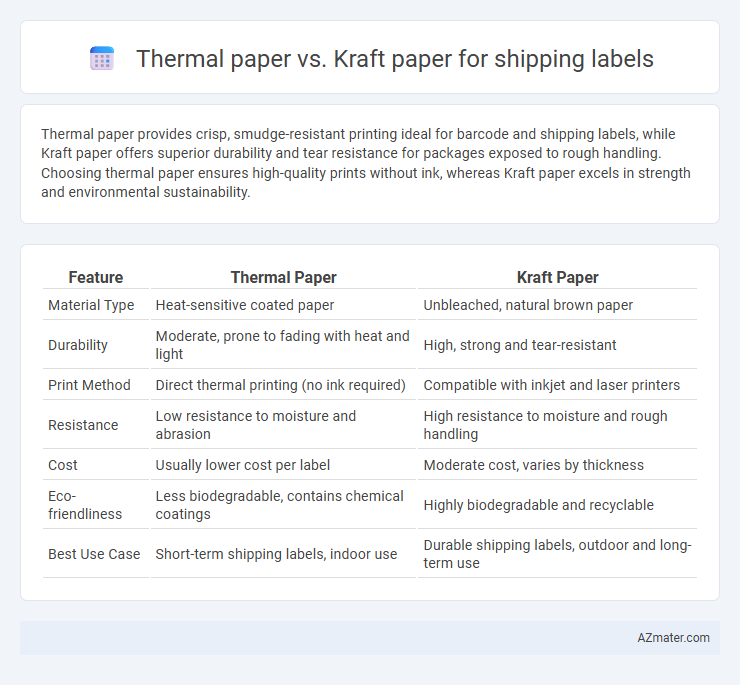Thermal paper provides crisp, smudge-resistant printing ideal for barcode and shipping labels, while Kraft paper offers superior durability and tear resistance for packages exposed to rough handling. Choosing thermal paper ensures high-quality prints without ink, whereas Kraft paper excels in strength and environmental sustainability.
Table of Comparison
| Feature | Thermal Paper | Kraft Paper |
|---|---|---|
| Material Type | Heat-sensitive coated paper | Unbleached, natural brown paper |
| Durability | Moderate, prone to fading with heat and light | High, strong and tear-resistant |
| Print Method | Direct thermal printing (no ink required) | Compatible with inkjet and laser printers |
| Resistance | Low resistance to moisture and abrasion | High resistance to moisture and rough handling |
| Cost | Usually lower cost per label | Moderate cost, varies by thickness |
| Eco-friendliness | Less biodegradable, contains chemical coatings | Highly biodegradable and recyclable |
| Best Use Case | Short-term shipping labels, indoor use | Durable shipping labels, outdoor and long-term use |
Introduction to Shipping Label Materials
Thermal paper and Kraft paper are two common materials used for shipping labels, each offering distinct advantages based on application needs. Thermal paper provides high-resolution printing through heat-sensitive technology, ideal for barcodes and quick label production without ink. Kraft paper offers durability and resistance to tearing, making it suitable for rough handling and outdoor shipping environments.
Overview of Thermal Paper
Thermal paper is a type of sensitive paper coated with a chemical layer that changes color when exposed to heat, making it ideal for thermal printers commonly used in shipping label applications. It offers high-resolution printing, fast processing, and resistance to smudging, which ensures clear and readable labels during transit and handling. Compared to kraft paper, thermal paper provides enhanced print quality and durability but may be less environmentally friendly due to its chemical coating.
Overview of Kraft Paper
Kraft paper is a durable, high-strength material commonly used for shipping labels due to its excellent tear resistance and eco-friendly composition made from wood pulp. It provides a rough texture that enhances ink adhesion and readability, making it ideal for long-term handling and outdoor shipping conditions. Compared to thermal paper, kraft paper offers greater durability and sustainability, which is favored in packaging that requires robust labeling and environmental responsibility.
Print Quality: Thermal vs Kraft Paper
Thermal paper offers superior print quality for shipping labels with high-resolution, crisp images and barcodes due to direct thermal printing technology. Kraft paper, typically used for its durability and eco-friendliness, produces lower print detail with ink-based printing methods, often resulting in less sharp and smudge-prone labels. For barcodes and detailed graphics, thermal paper's moisture-resistant surface ensures reliable scanner readability and consistent print clarity.
Durability and Resistance to Elements
Thermal paper offers moderate durability with sensitivity to heat and moisture, which can cause labels to fade or become illegible over time during shipping. Kraft paper provides superior resistance to tearing, water, and abrasion, making it ideal for long-term handling and exposure to harsh environmental conditions. Choosing Kraft paper enhances label longevity and reliability in demanding shipping scenarios where durability and element resistance are critical.
Environmental Impact and Sustainability
Thermal paper, often coated with BPA or BPS, poses environmental challenges due to its chemical composition and limited recyclability, contributing to higher landfill waste and potential toxicity. Kraft paper, derived from natural wood fibers and typically uncoated, offers superior biodegradability and recyclability, making it a more sustainable choice for shipping labels. Companies aiming to reduce their carbon footprint and promote eco-friendly packaging increasingly prefer kraft paper labels for their minimal environmental impact and renewable sourcing.
Cost Comparison
Thermal paper is generally more cost-effective for shipping labels due to its direct printing method, eliminating the need for ink or toner, which reduces ongoing expenses. Kraft paper labels tend to be pricier upfront because of their thicker, more durable material and the requirement for traditional printing methods, increasing both material and operational costs. For high-volume shipping operations, thermal paper offers significant savings by minimizing supply replenishment and maintenance costs.
Printer Compatibility and Ease of Use
Thermal paper offers superior printer compatibility with direct thermal printers, eliminating the need for ink or toner and enabling faster, quieter label production. Kraft paper labels, compatible mainly with laser and inkjet printers, may require additional adhesives and can slow down the printing process. Thermal paper's ease of use and reliability make it the preferred choice for high-volume shipping label applications.
Common Shipping Applications
Thermal paper is widely used for shipping labels in e-commerce and logistics due to its ability to produce clear, high-contrast barcodes and text without ink, which ensures efficient scanning during package handling. Kraft paper, known for its durability and resistance to tearing, is favored in heavy-duty shipping environments where labels must withstand rough handling and exposure to moisture or abrasion. Common shipping applications leverage thermal paper for rapid label printing and affordability, while kraft paper offers enhanced label longevity for parcels subjected to harsh transit conditions.
Choosing the Right Paper for Your Shipping Needs
Thermal paper offers high-quality printing with sharp barcodes and text, making it ideal for fast, thermal printers in high-volume shipping environments, while Kraft paper provides superior durability and resistance to tearing for labels exposed to rough handling or outdoor conditions. Choosing the right paper depends on the shipping environment, printer compatibility, and label longevity requirements, with thermal paper favored for indoor, short-term use and Kraft paper suitable for heavy-duty, long-term shipments. Assessing factors like moisture exposure, abrasion risk, and print clarity ensures optimal label performance and accurate package tracking.

Infographic: Thermal paper vs Kraft paper for Shipping label
 azmater.com
azmater.com